Indonesia Java International Destination Jakarta
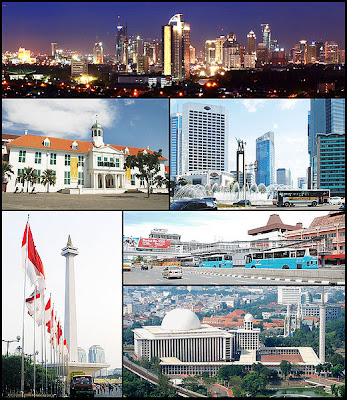
Jakarta, an Introduction
Jakarta (also DKI Jakarta) is the capital and largest city of Indonesia. Located on the northwest coast of Java, it has an area of 661 square kilometres (255 sq mi) and a population of 8,490,000. Jakarta is the country's economic, cultural and political center. It is themost populous city in Indonesia and Southeast Asia, and is the twelfth-largest city in the world. The metropolitan area, Jabodetabek, is thesecond largest in the world. Jakarta is listed as a global city in the 2008 Globalization and World Cities Study Group and Network (GaWC) research. The city's name is derived from the Sanskrit word "Jayakarta" which translates as "victorious deed," "complete act,"or "complete victory."
Jakarta History
Pre-Colonial era
The Jakarta area was part of the fourth century Indianized kingdom of Tarumanagara. In AD 39, King Purnawarman established Sunda Pura as a new capital city for the kingdom, located at the northern coast of Java. Purnawarman left seven memorial stones across the area with inscriptions bearing his name, including the present-day Banten and West Java provinces.
After the power of Tarumanagara declined, its territories, including Sunda Pura, became part of the Kingdom of Sunda. The harbour area was renamed Sunda Kalapa as written in a Hindu monk's lontar manuscripts. By the fourteenth century, Sunda Kelapa became a major trading port for the kingdom. The first European fleet, four Portuguese ships from Malacca, arrived in 1513 when the Portuguese were looking for a route forspices, especially black pepper. The Kingdom of Sunda made a peace agreement with Portugal by allowing the Portuguese to build a port in 1522 in order to defend against the rising power of the Sultanate of Demak from central Java.
In 1527, Fatahillah, a Sumatran Malay warrior from Demak attacked Kingdom of Sunda and succeeded in conquering the harbour on June 22, 1527, after which Sunda Kelapa was renamed Jayakarta. The ports became part of the Sultanate of Banten, that was created in the aftermath of conquest of Banten and Sunda Kelapa from Sunda kingdom. The sultanate would grew into a major trading center in Southeast Asia.
Through the relationship with Prince Jayawikarta from the Sultanate of Banten, Dutch ships arrived in Jayakarta in 1596. In 1602, the British East India Company's first voyage, commanded by Sir James Lancaster, arrived in Aceh and sailed on to Banten where they were allowed to build a trading post. This site became the center of British trade in Indonesia until 1682.
Jayawikarta is thought to have made trading connections with the English merchants, rivals of the Dutch, by allowing them to build houses directly across from the Dutch buildings in 1615.
Colonial era
When relations between Prince Jayawikarta and the Dutch deteriorated, Jayawikarta's soldiers attacked the Dutch fortress. Prince Jayakarta's army and the British were defeated by the Dutch, in part owing to the timely arrival of Jan Pieterszoon Coen (J.P. Coen). The Dutch burned the English fort, and forced the English to retreat on their ships. The victory consolidated Dutch power and in 1619 they renamed the city "Batavia."
Commercial opportunities in the capital of the Dutch colony attracted Indonesian and especially Chinese immigrants, the increasing numbers creating burdens on the city. Tensions grew as the colonial government tried to restrict Chinese migration through deportations. On 9 October 1740, 5,000 Chinese were massacred and the following year, Chinese inhabitants were moved to Glodok outside the city walls. The city began to move further south as epidemics in 1835 and 1870 encouraged more people to move far south of the port. The Koningsplein, nowMerdeka Square was completed in 1818, the housing park of Menteng was started in 1913, and Kebayoran Baru was the last Dutch-built residential area. By 1930 Batavia had more than 500,000 inhabitants, including 37,067 Europeans.
The Japanese renamed the city "Jakarta" during their World War II occupation of Indonesia.
Independence era
Following World War II, Indonesian Republicans withdrew from allied-occupied Jakarta during their fight for Indonesian independence and established their capital in Yogyakarta. In 1950, once independence was secured, Jakarta was once again made the national capital. Indonesia's founding president, Sukarno, envisaged Jakarta as a great international city. He instigated large government-funded projects undertaken with openly nationalistic and modernist architecture. Projects in Jakarta included a clover-leaf highway, a major boulevard (Jalan MH Thamrin-Sudirman), monuments such as The National Monument, major hotels, shopping centre, and a new parliament building.
In October 1965, Jakarta was the site of an abortive coup attempt which saw 6 top generals killed, and ultimately resulted in the downfall of Sukarno and the start of Suharto's "New Order. A propaganda monument stands at the place where the general's bodies were dumped. In 1966, Jakarta was declared a "special capital city district" (daerah khusus ibukota), thus gaining a status approximately equivalent to that of a state or province. Lieutenant General Ali Sadikin served as Governor from the mid-60's commencement of the "New Order" through to 1977; he rehabilitated roads and bridges, encouraged the arts, built several hospitals, and a large number of new schools. He also cleared out slum dwellers for new development projects-some for the benefit of the Suharto family-and tried to eliminate rickshaws and ban street vendors. He began control of migration to the city in order to stem the overcrowding and poverty. Foreign investment contributed to a real estate boom which changed the face of the city.
Infrastructure
Landmarks include the National Monument and Istiqlal Mosque. The city is the seat of the ASEAN Secretariat. Jakarta is served by the Soekarno-Hatta International Airport, Halim Perdanakusuma International Airport, and Tanjung Priok harbour; it is connected by several intercity and commuter railways, and served by several bus lines running on reserved busways.
Jakarta Overview
Officially, Jakarta is not a city, but a province with special status as the capital of Indonesia. It has a governor (instead of a mayor), and is divided into several sub-regions with their own administrative systems. As a province, the official name of Jakarta is Daerah Khusus Ibukota Jakarta ("Special Capital City District of Jakarta"), which in Indonesian is abbreviated to DKI Jakarta.
Jakarta is divided into five kota or kotamadya ("cities" - formerly municipalities), each headed by a mayor, and oneregency (kabupaten) headed by a regent. In August 2007, Jakarta held its first ever election to choose a governor, whereas previously the city's governors were appointed by local parliament. The poll is part of a country-wide decentralization drive, allowing for direct local elections in several areas.
The Cities/Municipalities of Jakarta are:
Central Jakarta (Jakarta Pusat) is Jakarta's smallest city and home to most of Jakarta's administrative and political center. It is characterized by large parks and Dutch colonial buildings. Landmarks include the National Monument (Monas), the Istiqlal Mosque, and museums.
West Jakarta (Jakarta Barat) has the highest concentration of small-scale industries in Jakarta. The area includes Jakarta's Chinatown and landmarks include the Chinese Langgam building and the Toko Merah building. West Jakarta contains part of the Jakarta Old Town.
South Jakarta (Jakarta Selatan), originally planned as a satellite city, is now the location of large upscale shopping centers and affluent residential areas. Jakarta Selatan functions as Jakarta's ground water buffer, but recently the green belt areas are threatened by new developments. Much of the CBD area of Jakarta is concentrated in Setia Budi, South Jakarta, bordering the Tanah Abang/Sudirman area of Central Jakarta.
East Jakarta (Jakarta Timur) territory is characterized with several industrial sectors erected in this city. There is also still some area of swamps and rice fields in this city.
North Jakarta (Jakarta Utara) is the only city in Jakarta that is bounded by the sea (Java Sea). It is the location of theTanjung Priok Port. Big-scale and medium-scale industries are concentrated in North Jakarta. North Jakarta contains the location of Jakarta Old Town, formerly known as Batavia since the 17th century, and was a center of VOC trade activity in Dutch East Indies. Also located in North Jakarta is Ancol Dreamland (Taman Impian Jaya Ancol), currently the largest integrated tourism area in South East Asia.
The only Regency (Kabupaten) of Jakarta is:
Thousand Islands (Kepulauan Seribu), formerly a subdistrict of North Jakarta, is a collection of 105 small islands located on Java Sea. It has a high conservation value because of its unique and special ecosystems. Marine tourism, such as diving, water bicycle, and wind surfing, is the most important touristic activities in this territory. The main transportation between these islands are speed boat or small ferries
Culture
As the economic and political capital of Indonesia, Jakarta attracts many domestic immigrants who bring their various languages, dialects, foods and customs.
 The Betawi (Orang Betawi, or "people of Batavia") is a term used to describe the descendants of the people living in and around Batavia and recognized as an ethnic group from around the 18th-19th century.The Betawi people are mostly descended from various Southeast Asian ethnic groups brought or attracted to Batavia to meet labor needs, and include people from different parts of Indonesia. The language and Betawi culture are distinct from those of the Sundanese or Javanese. The language is mostly based on the East Malay dialect and enriched by loan words from Sundanese, Javanese, Chinese, and Arabic. Nowadays, the Jakarta dialect Bahasa Jakarta) used as a street language by people in Jakarta is loosely based on the Betawi language.
The Betawi (Orang Betawi, or "people of Batavia") is a term used to describe the descendants of the people living in and around Batavia and recognized as an ethnic group from around the 18th-19th century.The Betawi people are mostly descended from various Southeast Asian ethnic groups brought or attracted to Batavia to meet labor needs, and include people from different parts of Indonesia. The language and Betawi culture are distinct from those of the Sundanese or Javanese. The language is mostly based on the East Malay dialect and enriched by loan words from Sundanese, Javanese, Chinese, and Arabic. Nowadays, the Jakarta dialect Bahasa Jakarta) used as a street language by people in Jakarta is loosely based on the Betawi language. Betawi arts are rarely found in Jakarta due to their infamous low-profile and most Betawi have moved to the border of Jakarta, displaced by new immigrants. It is easier to find Java or Minang based wedding ceremonial instead of Betawi weddings in Jakarta. It is easier to find Javanese Gamelan instead of Gambang Kromong (a mixture between Betawi and Chinese music) or Tanjidor (a mixture between Betawi and Portuguese music) or Marawis (a mixture between Betawi and Yaman music). However, some festivals such as the Jalan Jaksa Festival or Kemang Festival include efforts to preserve Betawi arts by inviting artists to give performances.
Betawi arts are rarely found in Jakarta due to their infamous low-profile and most Betawi have moved to the border of Jakarta, displaced by new immigrants. It is easier to find Java or Minang based wedding ceremonial instead of Betawi weddings in Jakarta. It is easier to find Javanese Gamelan instead of Gambang Kromong (a mixture between Betawi and Chinese music) or Tanjidor (a mixture between Betawi and Portuguese music) or Marawis (a mixture between Betawi and Yaman music). However, some festivals such as the Jalan Jaksa Festival or Kemang Festival include efforts to preserve Betawi arts by inviting artists to give performances.There has also been a Chinese community in Jakarta for many centuries. Officially, they make up 6% of the Jakarta population, though this number may be under-reported.
Cuisine
Jakarta has a vast range of food available at hundreds of eating complexes located all over the city. There is also international food, especially Indian, Chinese, Japanese, and Korean food because of the cosmopolitan population. One of the popular local cuisine of Jakarta is Soto betawi, which is a cow milk or coconut milk broth with beef tendons, intestines, tripe. The other popular cuisine are kerak telor, gado-gado, and cucur.
Tourist Attractions in Jakarta
Taman Mini Indonesia Indah
 This place is miniature of Indonesia, illustrated the diversity of cultures, customs and traditions in Indonesia. Here also there is Museum, please visit Festival Museum Nusantara.
This place is miniature of Indonesia, illustrated the diversity of cultures, customs and traditions in Indonesia. Here also there is Museum, please visit Festival Museum Nusantara.Ragunan Zoo Park
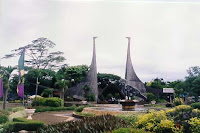 Ragunan zoo is a kind of combination between zoo and park. It has almost 30,000 plants from 250 different kinds of. Since it is a combination between zoo and park, Ragunan Zoo is also known as Ragunan Zoological Park.
Ragunan zoo is a kind of combination between zoo and park. It has almost 30,000 plants from 250 different kinds of. Since it is a combination between zoo and park, Ragunan Zoo is also known as Ragunan Zoological Park.Indonesia National Monument (Monas)
 Indonesia National Monument or what Indonesian and Jakarta people usually call as Monas is a monument built to remember the struggle of Indonesian heroes fighting the colonial domination.
Indonesia National Monument or what Indonesian and Jakarta people usually call as Monas is a monument built to remember the struggle of Indonesian heroes fighting the colonial domination.Jaya Ancol Dreamland Park (Taman Impian Jaya Ancol)
 Jaya Ancol Dreamland Park is a recreation area located at the seashore of Jakarta Gulf. Jaya Ancol Dreamland Park is better known as Ancol by most of Indonesian people. There’re several recreation facilities you can find at Jaya Ancol Dreamland Park: Golf Course, Ancol Marina Bay, Art Market (Pasar Seni), Dunia Fantasy, SeaWorld Indonesia, Gelanggang Samudera, Atlantis Water Adventure, andBeach Park (Taman Pantai). Jaya Ancol Dreamland Park provides facilities for those visitors who wants to stay in the Ancol area. Visitors can choose between three hotels and one cottage provided which respectively are Raddin Hotel, Mercure Hotel, Wisata Hotel and Putri Duyung Cottage.
Jaya Ancol Dreamland Park is a recreation area located at the seashore of Jakarta Gulf. Jaya Ancol Dreamland Park is better known as Ancol by most of Indonesian people. There’re several recreation facilities you can find at Jaya Ancol Dreamland Park: Golf Course, Ancol Marina Bay, Art Market (Pasar Seni), Dunia Fantasy, SeaWorld Indonesia, Gelanggang Samudera, Atlantis Water Adventure, andBeach Park (Taman Pantai). Jaya Ancol Dreamland Park provides facilities for those visitors who wants to stay in the Ancol area. Visitors can choose between three hotels and one cottage provided which respectively are Raddin Hotel, Mercure Hotel, Wisata Hotel and Putri Duyung Cottage.National Museum
 The National Museum of Indonesia (Indonesian: Museum Nasional), is an archeological, historical, ethnological, and geographicalmuseum located in Jakarta. Popularly known as Elephant Building (Indonesian: Gedung Gajah) after the elephant statue in its forecourt. Its broad and fascinating collections covers all of Indonesia's territory and almost all of its history. The museum has endeavoured to preserve Indonesia's heritage for two centuries.
The National Museum of Indonesia (Indonesian: Museum Nasional), is an archeological, historical, ethnological, and geographicalmuseum located in Jakarta. Popularly known as Elephant Building (Indonesian: Gedung Gajah) after the elephant statue in its forecourt. Its broad and fascinating collections covers all of Indonesia's territory and almost all of its history. The museum has endeavoured to preserve Indonesia's heritage for two centuries.Kota Tua Jakarta
 Kota Tua, Jakarta is an area of Dutch colonization inheritance which was well-known as Batavia in the 17th century. At Kota Tua area you can see old buildings with architecture style influenced by the Dutch or European architecture style, Chinese and even some of them with combination of Dutch and Chinese architecture. Some of the old buildings at Kota Tua area occupied as museums by the governor of DKI Jakarta. Kota Tua is one of a very interesting place or area to visit when you travel toJakarta since it’s a center of historical tourism object in Jakarta.
Kota Tua, Jakarta is an area of Dutch colonization inheritance which was well-known as Batavia in the 17th century. At Kota Tua area you can see old buildings with architecture style influenced by the Dutch or European architecture style, Chinese and even some of them with combination of Dutch and Chinese architecture. Some of the old buildings at Kota Tua area occupied as museums by the governor of DKI Jakarta. Kota Tua is one of a very interesting place or area to visit when you travel toJakarta since it’s a center of historical tourism object in Jakarta.Jakarta History Museum
 Jakarta History Museum is known as Fatahillah Museum. Jakarta History Museum provides information on Jakarta’s history, starting from the prehistoric age to current age, in a creative way, through the collections of the museum.
Jakarta History Museum is known as Fatahillah Museum. Jakarta History Museum provides information on Jakarta’s history, starting from the prehistoric age to current age, in a creative way, through the collections of the museum.Sunda Kelapa Harbor
 Along Sunda Kelapa Harbor you could see Phinisi ships in a line, which have unique shape and the body painted in some different colors. Phinisi ships were coming from many regions of Indonesia, carrying logs, rattan, copra and other agricultural products to Jakarta. When Phinisi goes back fromJakarta, it carries construction materials like steel and cement. You could see the hectic of loading and unloading activities that is still conducted traditionally at Sunda Kelapa.
Along Sunda Kelapa Harbor you could see Phinisi ships in a line, which have unique shape and the body painted in some different colors. Phinisi ships were coming from many regions of Indonesia, carrying logs, rattan, copra and other agricultural products to Jakarta. When Phinisi goes back fromJakarta, it carries construction materials like steel and cement. You could see the hectic of loading and unloading activities that is still conducted traditionally at Sunda Kelapa.Wayang Museum (Shadow Puppet Museum)
 Wayang is a theatrical performance employing puppets or human dancer. The puppet could be made of leather which perform shadow puppets play, or of wooden. Wayang Museum (used to be called as Shadow Puppet Museum as well) is a museum which keeps collections of wayang from various territories in Indonesia and even from other countries. The idea of building Wayang Museum started when H. Ali Sadikin, the governor of DKI Jakarta, attended the second wayang museum week in 1974. With the support of the committee of the wayang museum week, wayang lovers, and the governor of DKI Jakarta, then the building at Jalan Pintu Besar Utara # 27, West Jakarta decided to be Wayang Museum. The museum was officially open on 13th August, 1975 by the governor of DKI Jakarta, H. Ali Sadikin.
Wayang is a theatrical performance employing puppets or human dancer. The puppet could be made of leather which perform shadow puppets play, or of wooden. Wayang Museum (used to be called as Shadow Puppet Museum as well) is a museum which keeps collections of wayang from various territories in Indonesia and even from other countries. The idea of building Wayang Museum started when H. Ali Sadikin, the governor of DKI Jakarta, attended the second wayang museum week in 1974. With the support of the committee of the wayang museum week, wayang lovers, and the governor of DKI Jakarta, then the building at Jalan Pintu Besar Utara # 27, West Jakarta decided to be Wayang Museum. The museum was officially open on 13th August, 1975 by the governor of DKI Jakarta, H. Ali Sadikin.Fine Art and Ceramics Museum (Museum Senirupa dan Keramik)
 Fine Art and Ceramic Museum presents collections of ndonesian artist works of art from the era of 1800 to the current era. Fine Art and Ceramic Museum occupies a building, named Fine Art Hall. Before it’s occupied as a museum, the hall had been occupied by many organizations and instances from the time of Holland collonialization to the after independence time.
Fine Art and Ceramic Museum presents collections of ndonesian artist works of art from the era of 1800 to the current era. Fine Art and Ceramic Museum occupies a building, named Fine Art Hall. Before it’s occupied as a museum, the hall had been occupied by many organizations and instances from the time of Holland collonialization to the after independence time.Thousand Island (Pulau Seribu)
 Thousand Island lies in the waters of Jakarta Bay which has 100 miles length and 108,000 ha width. There’re about 110 islands, in some large and small group of islands in the Thousand Island. Those islands divided into tourism islands, conservation, historical island, and island for community empowerment in accordance with the characteristics differences between each island.
Thousand Island lies in the waters of Jakarta Bay which has 100 miles length and 108,000 ha width. There’re about 110 islands, in some large and small group of islands in the Thousand Island. Those islands divided into tourism islands, conservation, historical island, and island for community empowerment in accordance with the characteristics differences between each island.Jakarta Kota Station (BEOS)
 Jakarta Kota Station (also called BEOS by local people) is railway station of the Dutch inheritance. Jakarta Kota Station (BEOS) is located at the area of Kota Tua, Jakarta, and that’s why the name became Jakarta Kota Station. In the Dutch governmental time, Kota Tua Jakarta was well-known as Batavia. At that time Jakarta Kota Station (BEOS) was utilized to connect Batavia City with other areas near to Batavia, such as Bogor and Bandung.
Jakarta Kota Station (also called BEOS by local people) is railway station of the Dutch inheritance. Jakarta Kota Station (BEOS) is located at the area of Kota Tua, Jakarta, and that’s why the name became Jakarta Kota Station. In the Dutch governmental time, Kota Tua Jakarta was well-known as Batavia. At that time Jakarta Kota Station (BEOS) was utilized to connect Batavia City with other areas near to Batavia, such as Bogor and Bandung.You may wonder why Jakarta Kota Station is also called as Beos. BEOS is the abbreviation ofBataviasche Ooster Spoorweg Maatschapij (East Batavia Train Enterprise). In the glorious time of Batavia, BEOS station was also known as Batavia Zuid (South Batavia Station). Jakarta Kota Station was designed to have 12 railroads which is still utilized until now.
Textile Museum (Museum Tekstil)
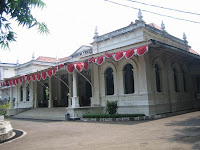 Textile Museum has thousands collections of traditional textiles with various motif and ornaments from each territories in Indonesia. Textile Museum occupies a very artistic and luxurious building. Inside the building there are display rooms used to display Indonesian textiles, including collections of the museum, designer and textile lover’s society. At the back side of the museum’s main building there is natural dye park which functioned to conserve and introduce the plants can be used as natural coloring material to the textile lovers. Even currently the natural dye has been replaced by synthetic color, however the shift in the use of material and tools not reducing the beauty of Indonesian textile.
Textile Museum has thousands collections of traditional textiles with various motif and ornaments from each territories in Indonesia. Textile Museum occupies a very artistic and luxurious building. Inside the building there are display rooms used to display Indonesian textiles, including collections of the museum, designer and textile lover’s society. At the back side of the museum’s main building there is natural dye park which functioned to conserve and introduce the plants can be used as natural coloring material to the textile lovers. Even currently the natural dye has been replaced by synthetic color, however the shift in the use of material and tools not reducing the beauty of Indonesian textile.Battle’45 Museum (Museum Joang ’45)
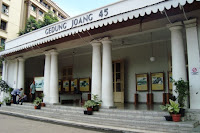 Battle’45 Museum (Museum Joang’45) collects inheritances from the Indonesian independence battle time, that used/worn by Indonesian warriors. Visiting Battle’45 Museum would increase your knowledge and insight about Indonesian journey from the colonization time until finally free and independent.
Battle’45 Museum (Museum Joang’45) collects inheritances from the Indonesian independence battle time, that used/worn by Indonesian warriors. Visiting Battle’45 Museum would increase your knowledge and insight about Indonesian journey from the colonization time until finally free and independent.Maritime Museum (Museum Bahari)
 Maritime Museum presents complete information about Indonesian nautical matters. Maritime Museum occupied two levels of building used as exhibition rooms from the total of three levels of floor in the building. Thes material used on the building dominated by wood. Large windows in the building functioned as ventilation, making the building has a good air circulation.
Maritime Museum presents complete information about Indonesian nautical matters. Maritime Museum occupied two levels of building used as exhibition rooms from the total of three levels of floor in the building. Thes material used on the building dominated by wood. Large windows in the building functioned as ventilation, making the building has a good air circulation.Schmutzer Primate Center (Pusat Primata Schmutzer)
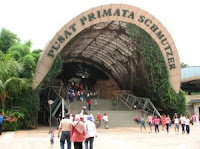 Schmutzer Primate Center is an artificial habitat of primates like gorilla, chimpanzee, orang utan and other kinds of primate. Schmutzer Primate Center is located at Ragunan Zoological Park area. Visitors of Schmutzer Primate Center can observe the behavior and activities of gorilla from a sky cross that was built over the area where gorillas inhabited. The sky cross for observation that’s covered by canopy roof is the main lane that visitors would find once they enter the building. The design of Schmutzer Primate Center was set close to the natural primate habitat with attractive layout of each room. The layout of Schmutzer accommodates the pleasure of primates as inhabitant and visitors who want to see the natural life of primates as in the wild nature.
Schmutzer Primate Center is an artificial habitat of primates like gorilla, chimpanzee, orang utan and other kinds of primate. Schmutzer Primate Center is located at Ragunan Zoological Park area. Visitors of Schmutzer Primate Center can observe the behavior and activities of gorilla from a sky cross that was built over the area where gorillas inhabited. The sky cross for observation that’s covered by canopy roof is the main lane that visitors would find once they enter the building. The design of Schmutzer Primate Center was set close to the natural primate habitat with attractive layout of each room. The layout of Schmutzer accommodates the pleasure of primates as inhabitant and visitors who want to see the natural life of primates as in the wild nature.Planetarium Jakarta
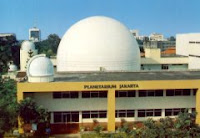 Planetarium Jakarta is an educational touring facility that presents simulations about astronomy and celestial objects. The existence of Planetarium Jakarta is very useful for Indonesian people, especially students, as it's really helpful in developing knowledge about earth and outer space science. The At Planetarium Jakarta you could see Planetarium Show, usually called as Star Theater. The show takes about 60 minutes time with various themes such as Solar System, Solar Eclipse and Lunar Eclipse, Little Explorer at Solar System, Our Galaxy is Bima Sakti, Earth, the Blue Planet, Multi Star and Variable Star, From Equator to Polar, Biography of the Star, and The Formation of Solar System. Besides the Star Theater show there’s also a multimedia show that explain the theories about solar as the center of solar system and the theories about the formation of universe.
Planetarium Jakarta is an educational touring facility that presents simulations about astronomy and celestial objects. The existence of Planetarium Jakarta is very useful for Indonesian people, especially students, as it's really helpful in developing knowledge about earth and outer space science. The At Planetarium Jakarta you could see Planetarium Show, usually called as Star Theater. The show takes about 60 minutes time with various themes such as Solar System, Solar Eclipse and Lunar Eclipse, Little Explorer at Solar System, Our Galaxy is Bima Sakti, Earth, the Blue Planet, Multi Star and Variable Star, From Equator to Polar, Biography of the Star, and The Formation of Solar System. Besides the Star Theater show there’s also a multimedia show that explain the theories about solar as the center of solar system and the theories about the formation of universe.Inscription Museum (Museum Prasasti)
 Inscriptions Museum occupies a culture preserve building, an inheritance building from the colonial time. It was formerly a funeral park of Dutch and European people which than restored and modified to be Inscription Museum with the collections located at the open air area. The collections are located at a 1.2 hectares area, and for it Inscription Museum is also called as Inscription Park. Inscription Museum exhibits selected gravestone inscriptions from the historical relic and work of arts from the past that combined the work of sculptor, carver, calligrapher, and man of letters.
Inscriptions Museum occupies a culture preserve building, an inheritance building from the colonial time. It was formerly a funeral park of Dutch and European people which than restored and modified to be Inscription Museum with the collections located at the open air area. The collections are located at a 1.2 hectares area, and for it Inscription Museum is also called as Inscription Park. Inscription Museum exhibits selected gravestone inscriptions from the historical relic and work of arts from the past that combined the work of sculptor, carver, calligrapher, and man of letters.Kota Intan Bridge
 Kota Intan Bridge was constructed in the 17th century by the Dutch government to connect the West Kali Besar and East Kali Besar. Kota Intan Bridge located at Kota Tua Jakarta which was known as Batavia on the time of Duta colonial. Kota Intan Bridge was made of wood and equipped with leverage to get the lower side of the bridge up when there was ship or boat passed by. In the Dutch colonial time the ships which deliver spicy from hinterland to the warehouse would pass by Kota Intan Bridge.
Kota Intan Bridge was constructed in the 17th century by the Dutch government to connect the West Kali Besar and East Kali Besar. Kota Intan Bridge located at Kota Tua Jakarta which was known as Batavia on the time of Duta colonial. Kota Intan Bridge was made of wood and equipped with leverage to get the lower side of the bridge up when there was ship or boat passed by. In the Dutch colonial time the ships which deliver spicy from hinterland to the warehouse would pass by Kota Intan Bridge.Syahbandar Tower - Jakarta
 Syahbandar Tower is located at the side of Jakarta Gulf Beach, next to the Maritime Museum and Sunda Kelapa Harbor. The current building of Maritime Museum was previously occupied as VOC’s (Vereenigde Oostindische Compagnie) spicy warehouse. VOC was a Dutch company which managed the trading activities on both sea and land for the interest of Nederland. Nederland constructed Syahbandar Tower to guide the traffic of ships that was coming for spicy trading at Sunda Kelapa Harbor.
Syahbandar Tower is located at the side of Jakarta Gulf Beach, next to the Maritime Museum and Sunda Kelapa Harbor. The current building of Maritime Museum was previously occupied as VOC’s (Vereenigde Oostindische Compagnie) spicy warehouse. VOC was a Dutch company which managed the trading activities on both sea and land for the interest of Nederland. Nederland constructed Syahbandar Tower to guide the traffic of ships that was coming for spicy trading at Sunda Kelapa Harbor.Jalan Surabaya (Surabaya Street)
 Jalan Surabaya is well known for the antiques market located there. Jalan Surabaya itself is located at Menteng area, at the Central of Jakarta. You can see kiosks/shops that sell antiques like wayang, porcelain, wooden sculptures, mask, eating stuffs made of silver and brass, antique lamp, metal souvenirs, old fashion ornaments, old telephon, old carema, old woven cloth, phonograph record, and some others. One of the kiosks there is selling antiques of ship stuffs like ship rudder, compass, telescope, and old diving stuffs. At the antique markets at Jalan Surabaya, there’re some kiosk that specialized on selling bags and suitcases. There’re also kiosks that sell old books.
Jalan Surabaya is well known for the antiques market located there. Jalan Surabaya itself is located at Menteng area, at the Central of Jakarta. You can see kiosks/shops that sell antiques like wayang, porcelain, wooden sculptures, mask, eating stuffs made of silver and brass, antique lamp, metal souvenirs, old fashion ornaments, old telephon, old carema, old woven cloth, phonograph record, and some others. One of the kiosks there is selling antiques of ship stuffs like ship rudder, compass, telescope, and old diving stuffs. At the antique markets at Jalan Surabaya, there’re some kiosk that specialized on selling bags and suitcases. There’re also kiosks that sell old books.In this article, there are many tourist attractions that have not been mentioned. Therefore, please visit Indonesia Java International Destination Jakarta. You will be guided by a professional guide to visit tourist places in around of Jakarta. This tour guide can you be found in hotels that spread throughout Jakarta.

0 comments:
Post a Comment